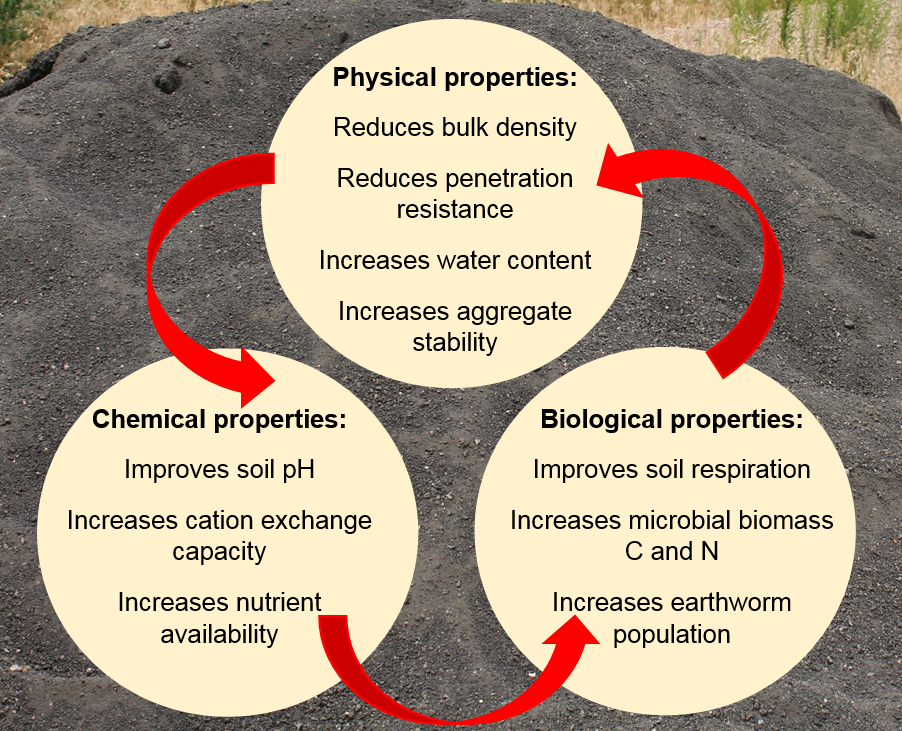Soil carbon (C) is an important indicator of soil health and an integral part of the physical, chemical, and biological properties of the soil. Loss of soil carbon can lead to soil degradation and loss of productivity.
Soil carbon is lost from the soil through erosion, residue removal, intensive tillage, and land-use changes. Carbon-enriched soil amendments, including animal manure, bio-solids, municipal compost, and biochar, among others, can restore soil productivity (Figure 1).
History of Carbon-Enriched Soil Amendment
Addition of carbon-enriched materials to the soil is not a new practice. Thousands of years ago, the indigenous people of the Amazon basin used charcoal-like material from cooking and heating as a soil amendment to agricultural soils. Through the addition of this carbon material, the indigenous people created what are now called the Terra Preta soils of the Amazon.
The Terra Preta soils are deep, dark brown, rich in nutrients, and contain significantly large amounts of soil organic matter compared to the surrounding soils. In addition, these soils have higher water-holding capacity; all of which make the soil highly valuable and productive. The Terra Preta soils are an excellent case study illustrating the long-term success of using high-carbon materials as soil amendments.
What Is High-Carbon Char?
Another potential carbon-enriched soil amendment with properties similar to biochar is char, also known as high-carbon char. High-carbon char is a residue from incomplete burning of coal such as during sugarbeet processing at the Western Sugar Cooperative near Scottsbluff.
 The plant produces 35,500 tons of high-carbon char per year from their sugar manufacturing process (Figure 2). High-carbon char from the Western Sugar Cooperative in Scottsbluff contains 30% carbon, 0.37% nitrogen, 0.22% phosphorus, 4.76% potassium, 4.76% calcium, 1.08% magnesium, and 0.51% sulfur in addition to many plant essential nutrients. Like other by-products recycled as soil amendments, including bio-solids and manure, potential contaminants need to be considered when using high-carbon char.
The plant produces 35,500 tons of high-carbon char per year from their sugar manufacturing process (Figure 2). High-carbon char from the Western Sugar Cooperative in Scottsbluff contains 30% carbon, 0.37% nitrogen, 0.22% phosphorus, 4.76% potassium, 4.76% calcium, 1.08% magnesium, and 0.51% sulfur in addition to many plant essential nutrients. Like other by-products recycled as soil amendments, including bio-solids and manure, potential contaminants need to be considered when using high-carbon char.
High-carbon char from the Western Sugar Cooperative contains heavy metals well below the EPA’s loading limit, making it safe for agricultural recycling.
Impacts on Crop Yield, Soil Properties
Researchers at the University of Nebraska–Lincoln are investigating the use of high-carbon char from Western Sugar Cooperative as a soil amendment to increase soil carbon, improve soil physicochemical properties and enhance crop productivity. Studies are being conducted on sandy loam soils near Sidney and Scottsbluff.
At Sidney, researchers applied high-carbon char at two sites (degraded and non-degraded) at six rates (0; 3,000; 6,000; 9,000; 12,000; and 18,000 lbs per acre) with four replications. The crop rotation consists of a three-year rotation of wheat, corn, and field peas. At Scottsbluff high-carbon char was applied at four neighboring fields (W1, W2, W5, and W6) at the Mitchell Agricultural Lab at five rates (0; 3,000; 6,000; 12,000; and 18,000 lbs per acre) with five replications. The crop rotation consists of a four-year rotation of corn, dry beans, corn, and sugarbeet.
High-carbon char was applied in spring 2016 and roto-tilled into the top 6 inches of soil at both sites (Figure 3). Soil was sampled at the 0-4 inch depth in spring 2017. The impact of high-carbon char on crop yield and soil physical and chemical properties including soil compaction properties (soil bulk density, penetration resistance, and shear strength), soil water content, cation exchange capacity, total carbon, and macro- and micronutrients was studied.
What Researchers Found
There was no significant increase in crop yield with high-carbon char application for the first year. In addition, high-carbon char had minimal influence on soil physical and chemical properties. Bulk density and shear strength were unaffected by high-carbon char application at the Sidney and Scottsbluff sites.
However, the degraded site in Sidney showed a trend of reduced penetration resistance, indicating that roots could more easily penetrate through the soil where high-carbon char had been added. In addition, results from one of the fields near Scottsbluff (W2 field) showed a significant increase in soil water content. At the degraded site near Sidney, total carbon content increased by 90% with 9,000 lbs per acre and 149% with 18,000 lbs per acre of high-carbon char application compared with control (no high-carbon char) plots.
Conclusion
Use of high-carbon char as a soil amendment can increase soil carbon concentration. For example, total carbon content increased by 149% with 18,000 lbs per acre of high-carbon char application in the Sidney degraded site. High-carbon char, in general, had no effect on crop yield and soil physical properties in the first year.
High-carbon char may have positive effects on crop yield and soil properties in the long-term as it takes time for the char particles to react with soil particles. Overall, high-carbon char shows promise as a soil amendment, but long-term monitoring is needed to determine the impacts of high-carbon char on soil properties and crop yields.






Post a comment
Report Abusive Comment